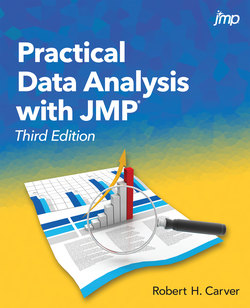Читать книгу Practical Data Analysis with JMP, Third Edition - Robert Carver - Страница 4
На сайте Литреса книга снята с продажи.
ОглавлениеContents
About This Book
About The Author
Chapter 1: Getting Started: Data Analysis with JMP
Overview
Goals of Data Analysis: Description and Inference
Types of Data
Starting JMP
A Simple Data Table
Graph Builder: An Interactive Tool to Explore Data
Using an Analysis Platform
Row States
Exporting and Sharing JMP Reports
Saving and Reproducing Your Work
Leaving JMP
Chapter 2: Data Sources and Structures
Overview
Populations, Processes, and Samples
Representativeness and Sampling
Cross-Sectional and Time Series Sampling
Study Design: Experimentation, Observation, and Surveying
Creating a Data Table
Raw Case Data and Summary Data
Application
Chapter 3: Describing a Single Variable
Overview
The Concept of a Distribution
Variable Types and Their Distributions
Distribution of a Categorical Variable
Using Graph Builder to Explore Categorical Data Visually
Distribution of a Quantitative Variable
Using the Distribution Platform for Continuous Data
Exploring Further with the Graph Builder
Summary Statistics for a Single Variable
Application
Chapter 4: Describing Two Variables at a Time
Overview
Two-by-Two: Bivariate Data
Describing Covariation: Two Categorical Variables
Describing Covariation: One Continuous, One Categorical Variable
Describing Covariation: Two Continuous Variables
Application
Chapter 5: Review of Descriptive Statistics
Overview
The World Development Indicators
Questions for Analysis
Applying an Analytic Framework
Preparation for Analysis
Univariate Descriptions
Explore Relationships with Graph Builder
Further Analysis with the Multivariate Platform
Further Analysis with Fit Y by X
Summing Up: Interpretation and Conclusions
Visualizing Multiple Relationships
Chapter 6: Elementary Probability and Discrete Distributions
Overview
The Role of Probability in Data Analysis
Elements of Probability Theory
Contingency Tables and Probability
Discrete Random Variables: From Events to Numbers
Three Common Discrete Distributions
Simulating Random Variation with JMP
Discrete Distributions as Models of Real Processes
Application
Chapter 7: The Normal Model
Overview
Continuous Data and Probability
Density Functions
The Normal Model
Normal Calculations
Checking Data for the Suitability of a Normal Model
Generating Pseudo-Random Normal Data
Application
Chapter 8: Sampling and Sampling Distributions
Overview
Why Sample?
Methods of Sampling
Using JMP to Select a Simple Random Sample
Variability Across Samples: Sampling Distributions
Application
Chapter 9: Review of Probability and Probabilistic Sampling
Overview
Probability Distributions and Density Functions
The Normal and t Distributions
The Usefulness of Theoretical Models
When Samples Surprise Us: Ordinary and Extraordinary Sampling Variability
Conclusion
Chapter 10: Inference for a Single Categorical Variable
Overview
Two Inferential Tasks
Statistical Inference Is Always Conditional
Using JMP to Conduct a Significance Test
Confidence Intervals
Using JMP to Estimate a Population Proportion
A Few Words about Error
Application
Chapter 11: Inference for a Single Continuous Variable
Overview
Conditions for Inference
Using JMP to Conduct a Significance Test
What If Conditions Are Not Satisfied?
Using JMP to Estimate a Population Mean
Matched Pairs: One Variable, Two Measurements
Application
Chapter 12: Chi-Square Tests
Overview
Chi-Square Goodness-of-Fit Test
Inference for Two Categorical Variables
Contingency Tables Revisited
Chi-Square Test of Independence
Application
Chapter 13: Two-Sample Inference for a Continuous Variable
Overview
Conditions for Inference
Using JMP to Compare Two Means
Using JMP to Compare Two Variances
Application
Chapter 14: Analysis of Variance
Overview
What Are We Assuming?
One-Way ANOVA
What If Conditions Are Not Satisfied?
Including a Second Factor with Two-Way ANOVA
Application
Chapter 15: Simple Linear Regression Inference
Overview
Fitting a Line to Bivariate Continuous Data
The Simple Regression Model
What Are We Assuming?
Interpreting Regression Results
Application
Chapter 16: Residuals Analysis and Estimation
Overview
Conditions for Least Squares Estimation
Residuals Analysis
Estimation
Application
Chapter 17: Review of Univariate and Bivariate Inference
Overview
Research Context
One Variable at a Time
Life Expectancy by Income Group
Life Expectancy by GDP per Capita
Conclusion
Chapter 18: Multiple Regression
Overview
The Multiple Regression Model
Visualizing Multiple Regression
Fitting a Model
A More Complex Model
Residuals Analysis in the Fit Model Platform
Using a Regression Tree Approach: The Partition Platform
Collinearity
Evaluating Alternative Models
Application
Chapter 19: Categorical, Curvilinear, and Non-Linear Regression Models
Overview
Dichotomous Independent Variables
Dichotomous Dependent Variable
Curvilinear and Non-Linear Relationships
More Non-Linear Functions
Application
Chapter 20: Basic Forecasting Techniques
Overview
Detecting Patterns Over Time
Smoothing Methods
Trend Analysis
Autoregressive Models
Application
Chapter 21: Elements of Experimental Design
Overview
Why Experiment?
Goals of Experimental Design
Factors, Blocks, and Randomization
Multi-Factor Experiments and Factorial Designs
Blocking
A Design for Main Effects Only
Definitive Screening Designs
Non-Linear Response Surface Designs
Application
Chapter 22: Quality Improvement
Overview
Processes and Variation
Control Charts
Variability Charts
Capability Analysis
Pareto Charts
Application
Bibliography
Index
